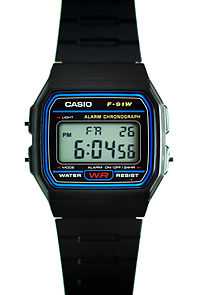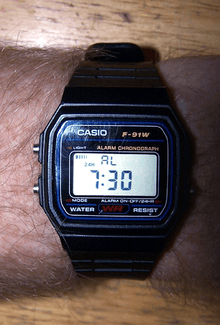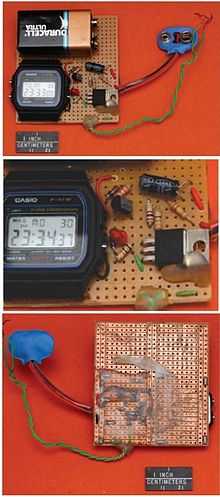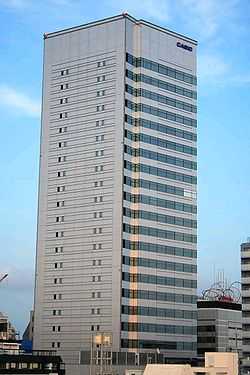Casio F-91W
 | |
| Type | Quartz |
|---|---|
| Display | Digital |
| Introduced | 1991[1] |
The Casio F-91W is a quartz digital watch, manufactured by the Japanese firm Casio Computer Co., Ltd.. It was introduced in 1991.[1] The watch is available in several countries. Casio does not release sales figures for the watch, but says the watch continues to sell well.[1]
Specifications
The F-91W has a 1/100 second stopwatch with a count up to 59:59.99 (nearly one hour) and measuring modes of net time, split time, and 1st and 2nd place times. There are the options of an hourly time beep and a single daily alarm. It has an automatic calendar, although auto-adjustment for leap years is not supported, as the watch does not record the year.[2] The watch is reported to be as accurate as ±30 seconds per month[2] (6 minutes per year) by the manufacturer.
The watch is powered by a single CR2016 lithium button cell, which Casio claims will last approximately seven years (assuming 20 seconds of alarm and one second of light usage per day). The watch case measures 37.5 × 33.5 × 9.5 mm and weighs 20 g. The manufacturer's module number for this model (stamped on the stainless steel rear of the watch case) is 593.
There are similar variations of the F-91W, such as the Casio A-158W, A-168WA (metallic band) and F-94W (available mainly in South East Asia), that have similar specifications and operational features. The F-105W has similar specifications but uses electroluminescence, also known as EL, rather than a small light bulb to illuminate the display.
Water resistance
The watch front is marked WATER RESIST.,[2] but Casio reports different values for nominally the same watch. The black version (F91W-1XY)[3] is "30 Meter / 3 Bar", the ISO standard meaning of which is: "Suitable for everyday use. Splash/rain resistant. NOT suitable for showering, bathing, swimming, snorkelling, water related work and fishing.", but the colored versions (e.g. F-91WC-2AEF) are "DIN 8310 / ISO 2281- resistant to minor splashing".
Operation

The watch is controlled by three side push-buttons. The upper left button turns on the backlight, cancels the alarm, and is used for selecting settings. The lower left button cycles the modes of the watch: → Alarm → Stopwatch → Time adjustment and back to the normal time display. The button on the right is the function button: when used after pressing the lower left mode button it starts and stops the stopwatch, or changes the settings currently being adjusted; but when pressed alone switches between the 12- and 24-hour modes.[4]
The time or date is adjusted by pressing the lower left button three times to bring the watch to time adjustment mode. This causes the seconds to flash on the display. The top left button is pressed to cycle through seconds, hours, minutes, month, date, day, and normal mode. The right button is then pressed to adjust the flashing value displayed. When the adjustments are finished, the bottom left button is pressed repeatedly until the watch returns to normal mode.
The watch display shows the day of the week, day of the month, hour, minute, seconds, and the signs for PM or 24H (24-hour clock), alarm signal, and hourly signal (double beep on the hour).
In stopwatch mode, minutes, seconds and hundredths of a second are shown.
Claimed use in terrorism

According to The Guardian, "the Casio F-91W digital watch was declared to be 'the sign of al-Qaeda' and a contributing factor to continued detention of prisoners by the analysts stationed at Guantánamo Bay. Briefing documents used to train staff in assessing the threat level of new detainees advise that possession of the F-91W – available online for as little as £4 – suggests the wearer has been trained in bomb making by al-Qaida in Afghanistan."[5] United States Military intelligence officials have identified the F91W as a watch that terrorists use when constructing time bombs.[6][7][8][9][10]
This association was highlighted in the Denbeaux study, and may have been used in some cases at the Guantanamo Bay detention camp.[11] An article published in the Washington Post in 1996 reported that Abdul Hakim Murad, Wali Khan Amin Shah, and Ramzi Ahmed Yousef had developed techniques to use commonly available Casio digital watches to detonate time bombs.[12]
References
- ↑ 1.0 1.1 1.2 Denise Winterman (April 26, 2011). "Casio F-91W: The strangely ubiquitous watch". BBC News magazine. Retrieved April 27, 2011.
- ↑ 2.0 2.1 2.2 "F91W-1 Classic Timepiece". Casio. Retrieved April 27, 2011.
- ↑ "F-91W-1XY". Casio. Retrieved May 22, 2013.
- ↑ "Manual". Casio. Retrieved November 26, 2014.
- ↑ James Ball (April 25, 2011). "Guantánamo Bay files: Casio wristwatch 'the sign of al-Qaida'". The Guardian (London).
- ↑ "USA v. al Qahtani" (PDF). US Department of Defense. November 7, 2005. Retrieved February 27, 2007.
- ↑ "Combatant status review board for Mohammed Ahmad Said el Edah". The New York Times. October 6, 2004.
- ↑ "Why Am I in Cuba?". Mother Jones. July 12, 2006.
- ↑ "Guantanamo Captives Jailed Because Of Digital Watches". WCVB. March 10, 2006.
- ↑ "Summary of Evidence memo (.pdf) prepared for Sabri Mohammed Ebrahim Al Qurashi's Combatant Status Review Tribunal – page 216". October 13, 2004.
- ↑ "Empty Evidence". National Journal. February 3, 2006.
- ↑ R. Jeffrey Smith (July 21, 1996). "New Devices May Foil Airline Security". Washington Post. pp. A01. Retrieved March 14, 2008.
External links
 Media related to Casio F91W at Wikimedia Commons
Media related to Casio F91W at Wikimedia Commons Media related to IED timers that use a Casio f91w at Wikimedia Commons
Media related to IED timers that use a Casio f91w at Wikimedia Commons- F91W-1 product page, Casio website
| |||||||||||||||||||||||||||||||||||||||||||||||||||
